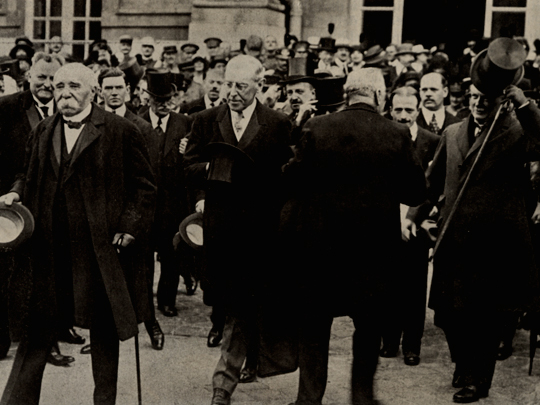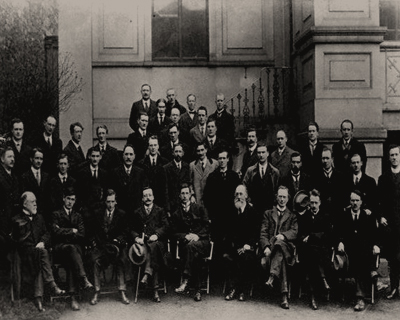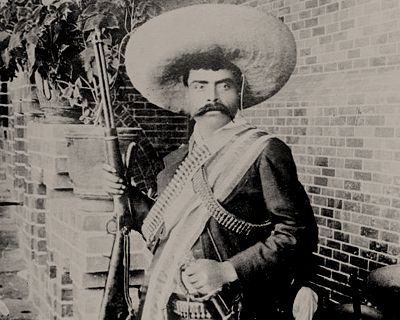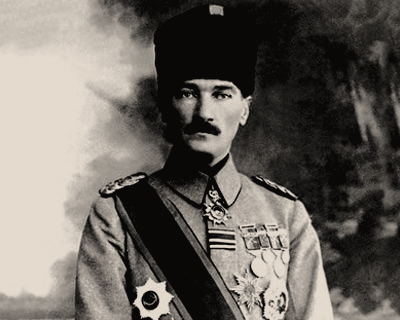
Wikimedia Commons / CC-BY-SA-3.0 / GFDL
1 – The Treaty of Versailles was signed
The Treaty of Versailles was one of the peace treaties at the end of World War I. It ended the state of war between Germany and the Allied Powers.
It was signed on 28 June 1919, exactly five years after the assassination of Archduke Franz Ferdinand.
The other Central Powers on the German side of World War I were dealt with in separate treaties.
Although the armistice, signed on 11 November 1918, ended the actual fighting, it took six months of negotiations at the Paris Peace Conference to conclude the peace treaty.
The treaty was registered by the Secretariat of the League of Nations on 21 October 1919.
Of the many provisions in the treaty, one of the most important and controversial required “Germany [to] accept the responsibility of Germany and her allies for causing all the loss and damage” during the war.
This later became known as the War Guilt clause. The treaty forced Germany to disarm, concede substantial territory, and pay reparations to certain countries that had formed the Entente powers.
In 1921 the total cost of these reparations was assessed at 132 billion Marks (then $31.4 billion or £6.6 billion, roughly equivalent to $442 billion or £284 billion in 2016).
2 – Ireland declares independence from Great Britain, sparking the Irish War of Independence

Dáil Éireann was the revolutionary parliament of the Irish Republic from 1919 to 1922. The Dáil was first formed by 73 Sinn Féin MPs elected in the 1918 United Kingdom general election.
Their manifesto refused to recognize the British parliament at Westminster and chose instead to establish an independent legislature in Dublin. The convention of the First Dáil coincided with the beginning of the War of Independence.
This was followed by the Second Dáil in 1921. Both of these Dála existed under the law of the Irish Republic and it was the Second Dáil that narrowly ratified the Anglo-Irish Treaty.
The status of the Third Dáil of 1922–1923 was different as it was also recognized by the British.
It was elected under the terms of the 1921 Anglo-Irish Treaty as a provisional parliament to pave the way for the creation of an independent Irish state.
With the establishment of the Irish Free State in 1922, a new parliament called the Oireachtas was established, of which Dáil Éireann became the lower house.
3 – Mexican Revolution leader Emiliano Zapata is ambushed and shot dead by government forces

Emiliano Zapata Salazar was a leading figure in the Mexican Revolution, the main leader of the peasant revolution in the state of Morelos, and the inspiration of the agrarian movement called Zapatismo.
He is considered to be one of the national heroes of Mexico.
In 1915, Zapata initiated guerrilla warfare against the Carrancistas (Venustiano Carranza’s men), who in turn invaded Morelos, employing scorched earth tactics to oust the Zapatista rebels.
Zapata once again retook Morelos in 1917 and held most of the state against Carranza’s troops until he was killed in an ambush in April 1919.
With a bounty on Zapata’s head, on April 9, a General Guajardo invited Zapata for a meeting, pretending to be friendly with him.
When Zapata arrived, Guajardo riddled him with bullets and turned his body in for the bounty, only getting half of what was originally promised.
Zapata’s influence is still visible today, particularly in the revolutionary tendencies of southern Mexico.
4 – Samil Movement begins in Korea
The Samil Movement, also known as the March 1st Movement, was one of the earliest public displays of Korean resistance during the ruling of Korea by Japan.
The name refers to an event that occurred on March 1, 1919, hence the movement’s name, literally meaning “Three-One Movement” or “March First Movement” in Korean.
Campaigners held nonviolent rallies in Seoul, Pyongyang and other cities on March 1st, and over the next two days groups organized more rallies and marches in the vast majority of the country’s cities and towns.
However, the Japanese power holders’ response was brutally violent. By April 10th, more than 300 cities had held nonviolent parades, demonstrations and nonviolent raids of Japanese outposts.
In all, the pro-independence groups held more than 1500 protest gatherings, in which more than two million civilians took part.
The number of deaths is estimated to be around 7,500, along with 46,000 arrests.
Despite the campaign’s failure to achieve its goal of independence, March First is celebrated as a national holiday in both North and South Korea today.
The campaign for Korean independence is remembered as the most serious act of resistance to Japanese power of its time, and as an example of nonviolent struggle against a foreign power.
5 – Mustafa Kemal Atatürk lands at Samsun, initiating the Turkish War of Independence

On 19 May 1919, Kemal Ataturk reached Samsun.
He established an organized national movement against the occupying forces and, on June 1919, he issued the Amasya Circular, declaring the independence of the country was in danger.
These proved to be the first moments in the Turkish War of Independence.
Having established a provisional government in Ankara, he defeated the forces sent by the Allies, eventually leading to victory in the Turkish War of Independence.
It would not be until 29 October 1923, that the Republic of Turkey was proclaimed.
Atatürk then embarked upon a program of political, economic, and cultural reforms, seeking to transform the former Ottoman Empire into a modern and secular nation-state.
Under his leadership, thousands of new schools were built, primary education was made free and compulsory, and women were given equal civil and political rights, while the burden of taxation on peasants was reduced.